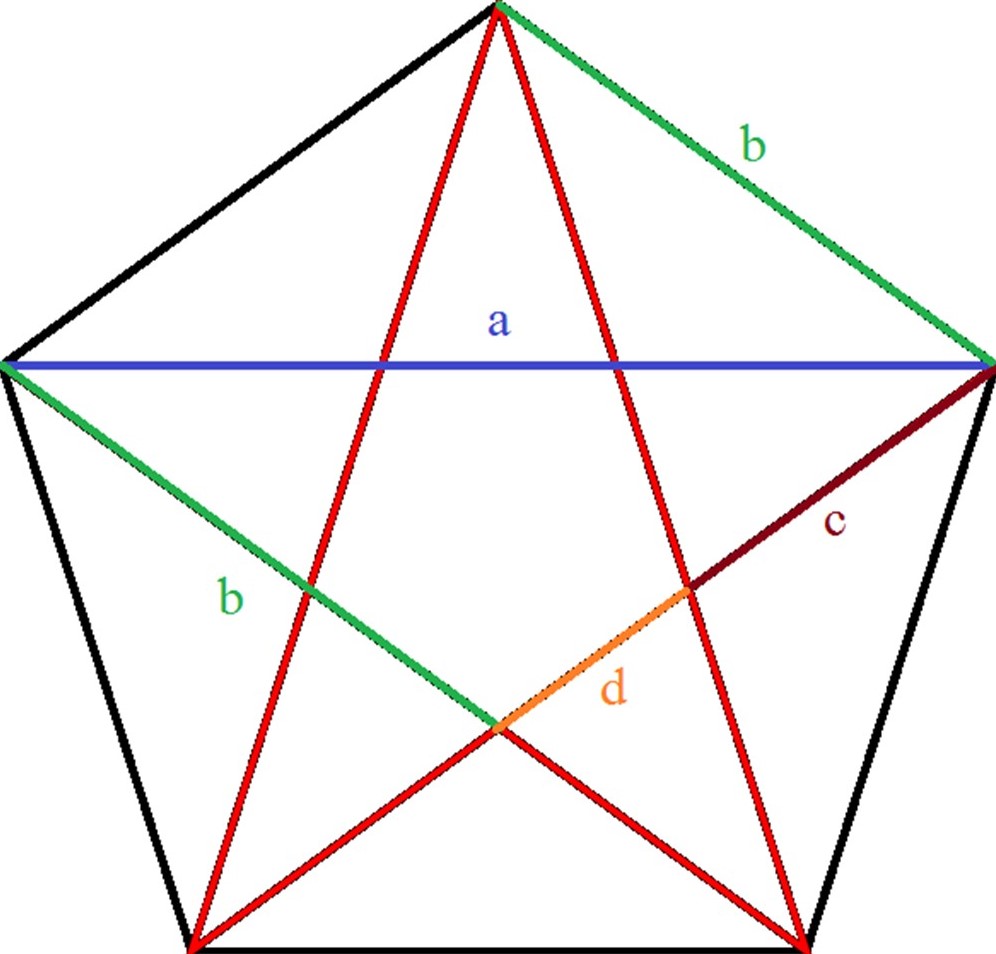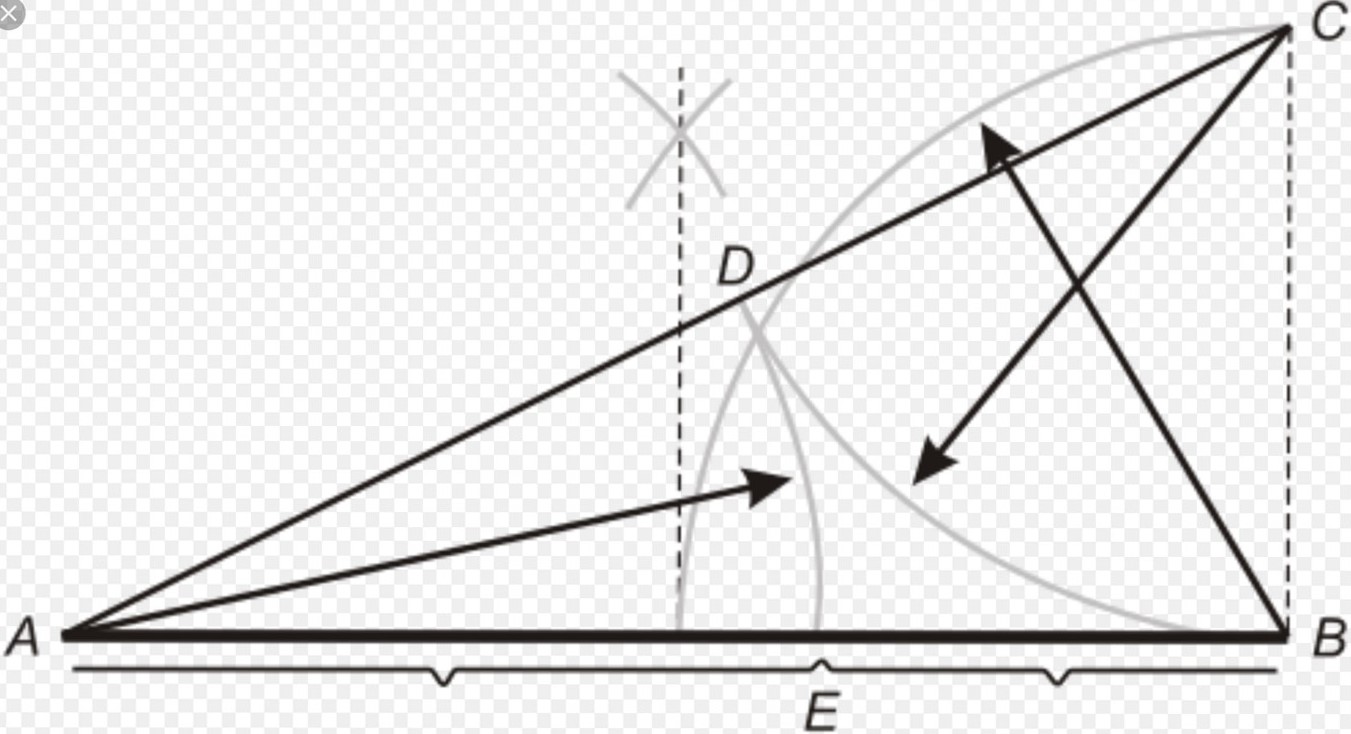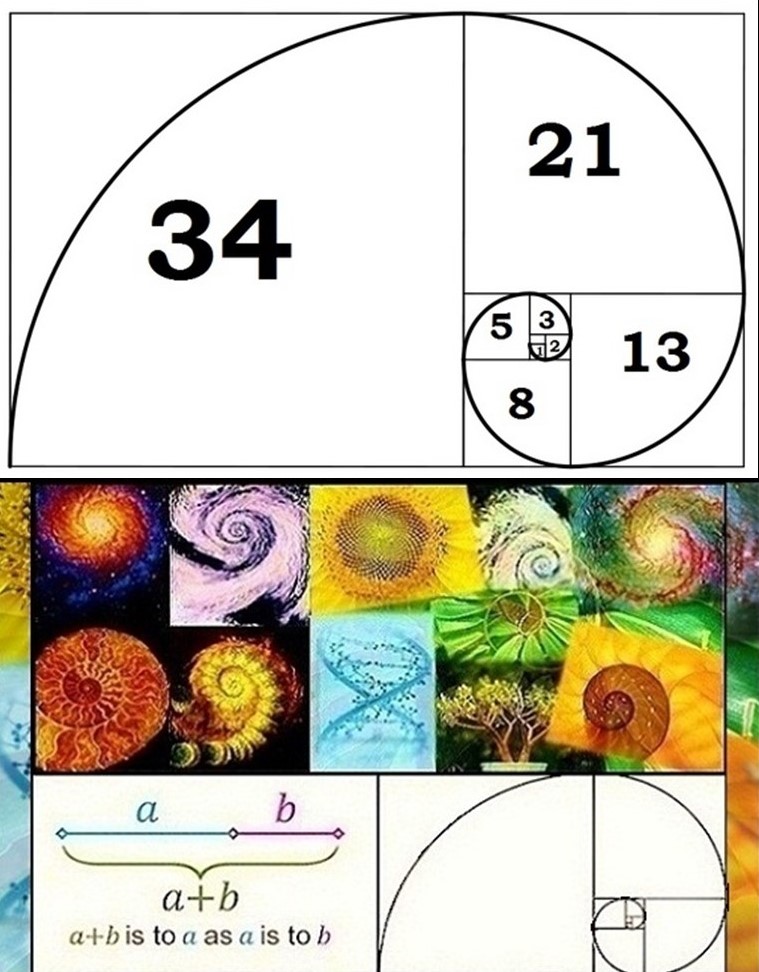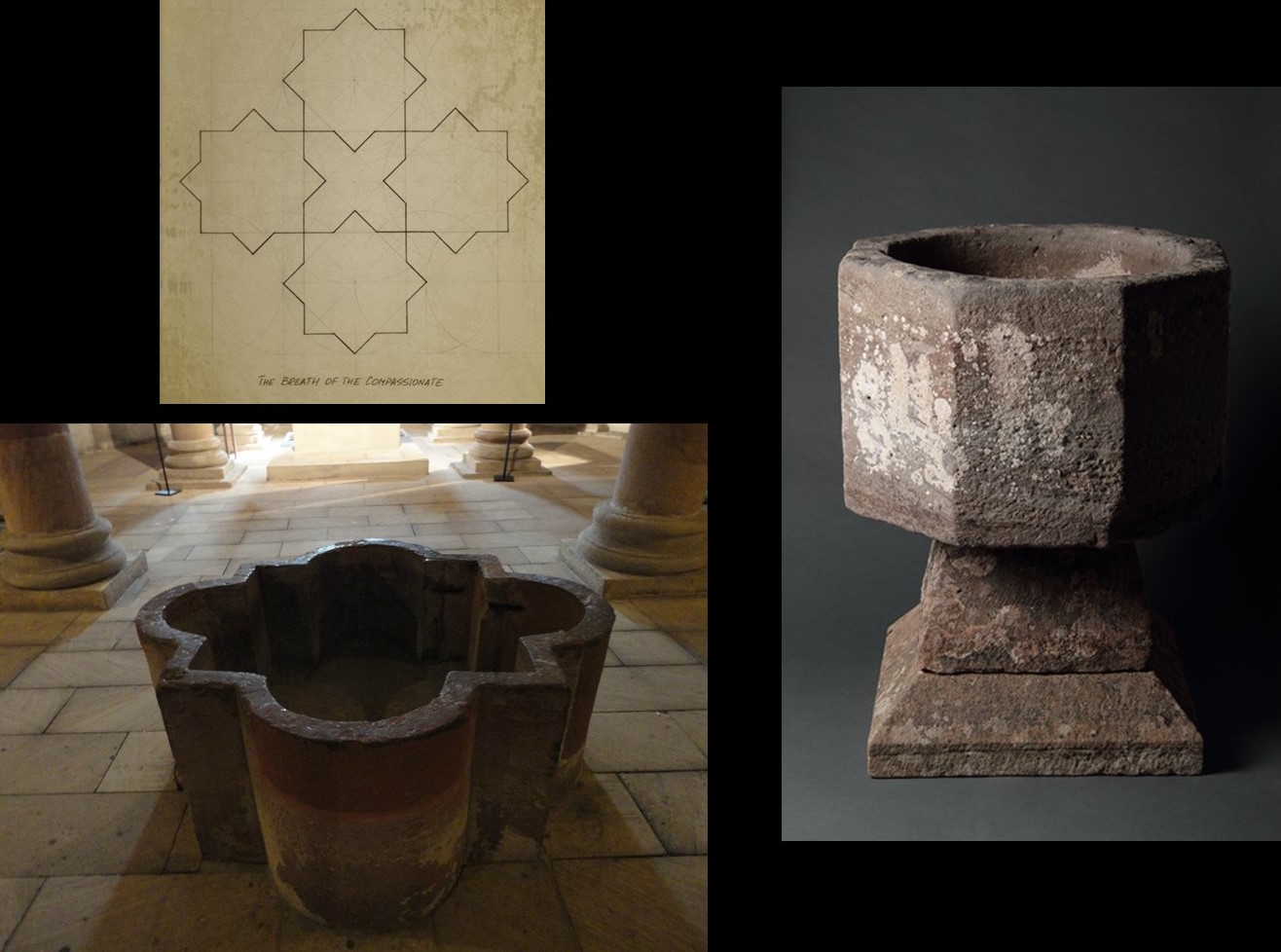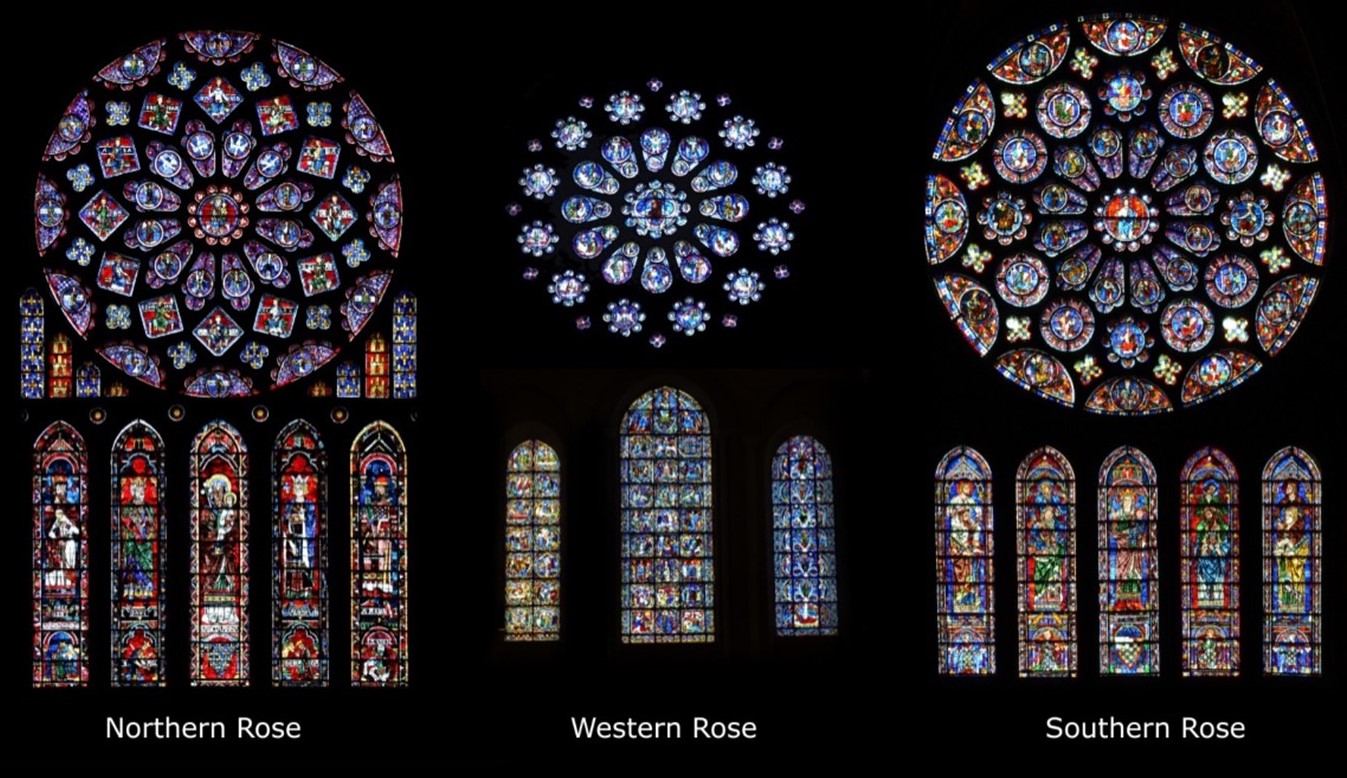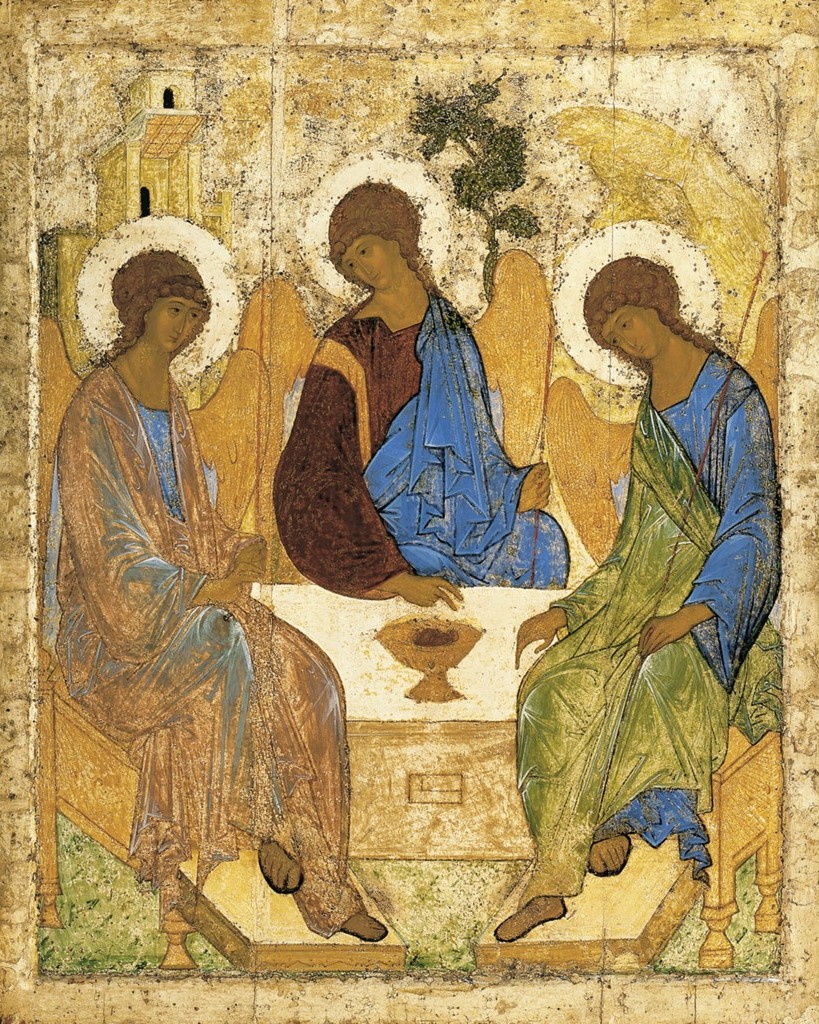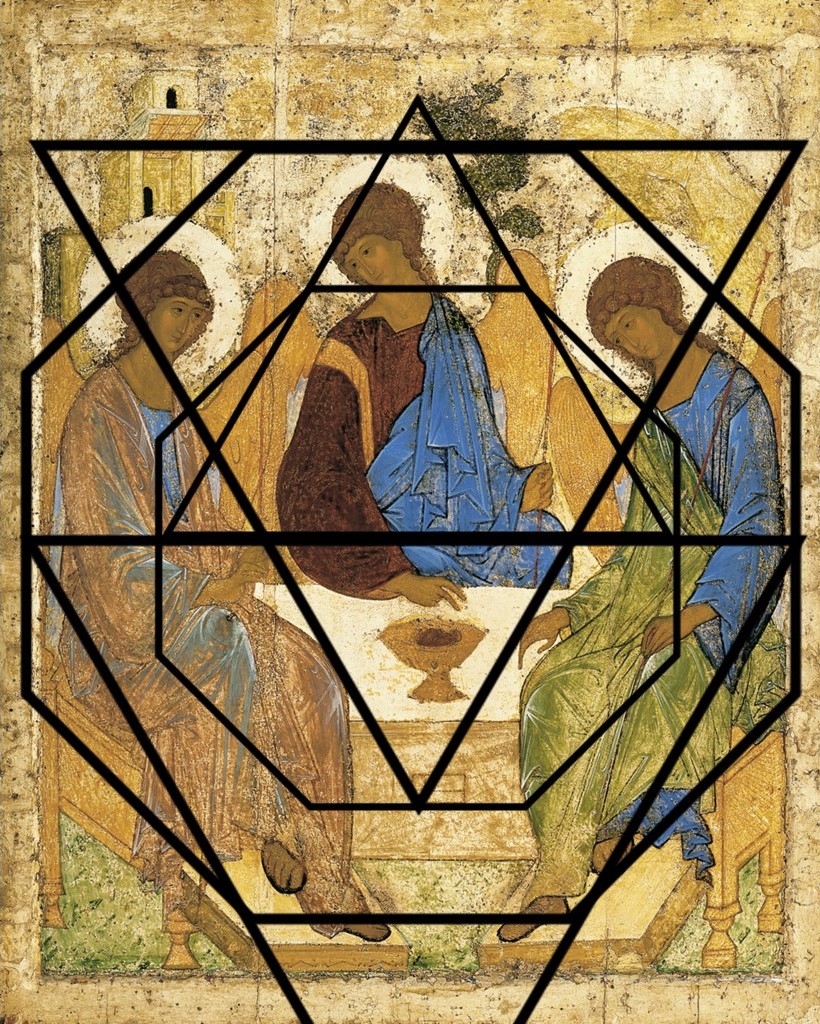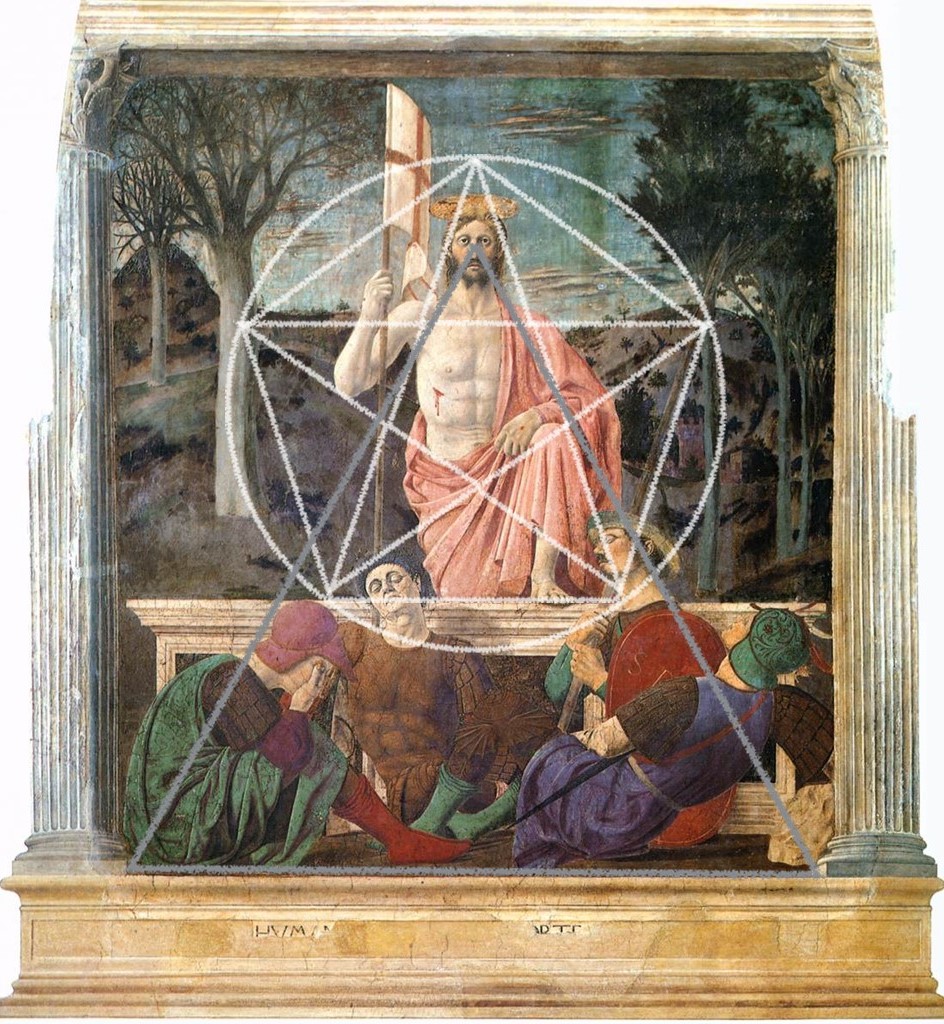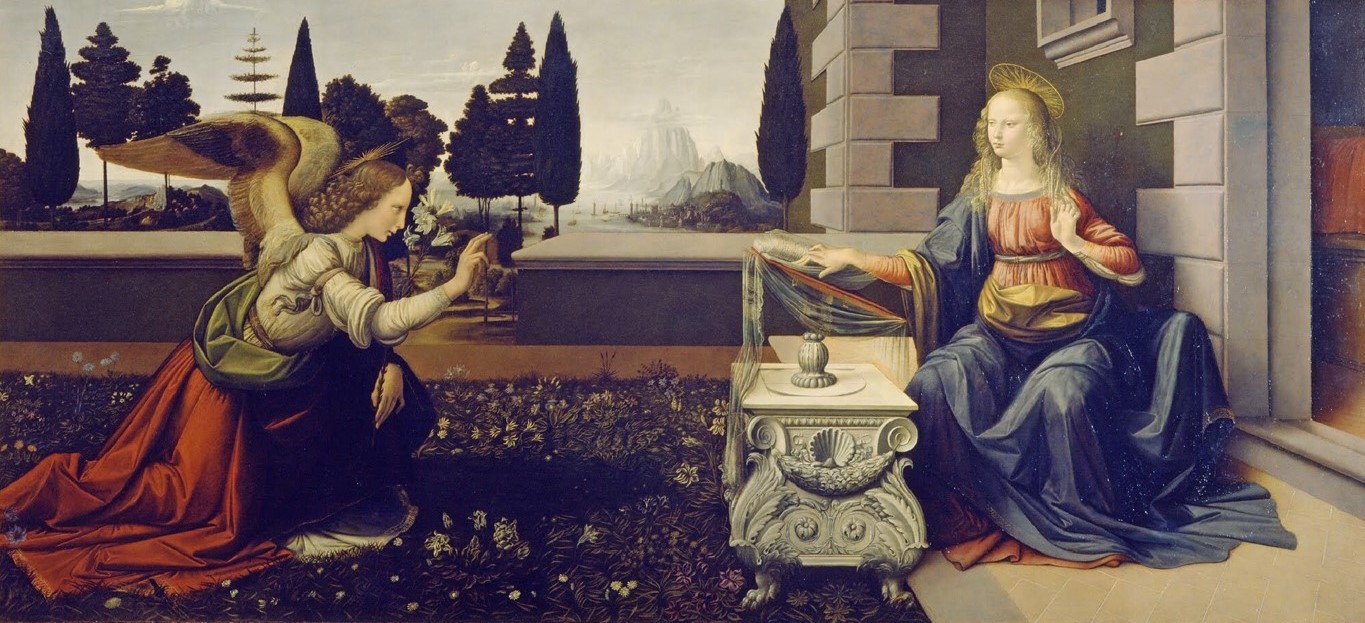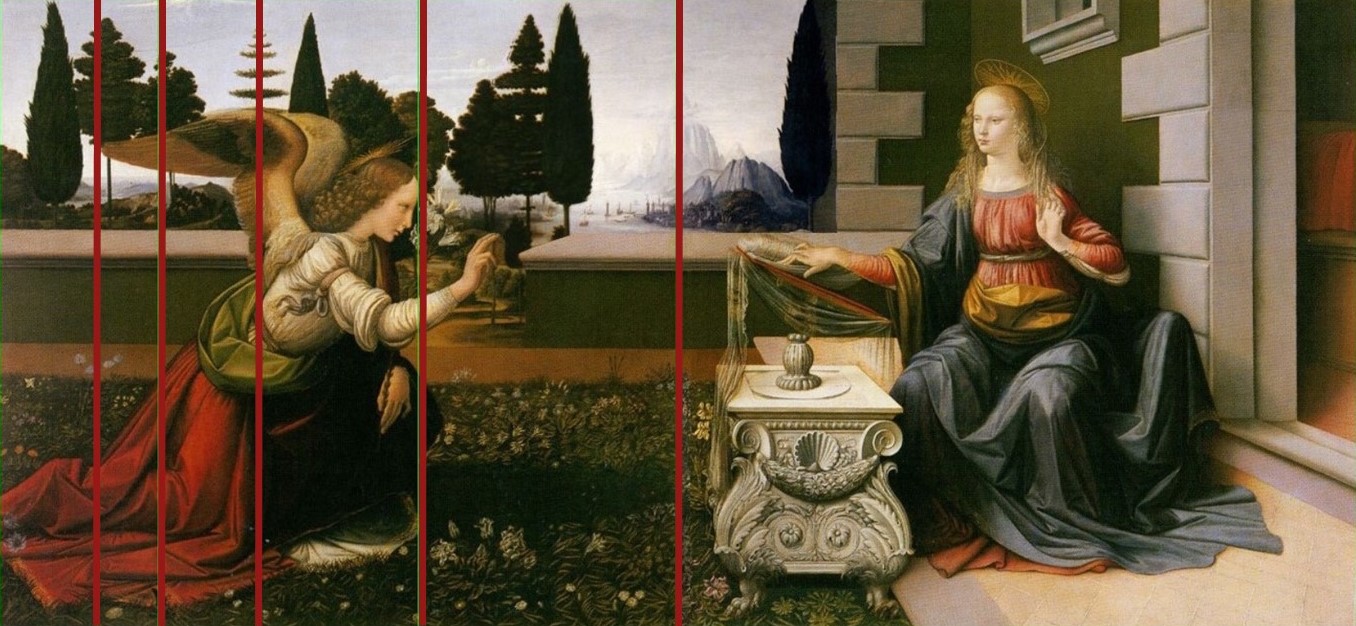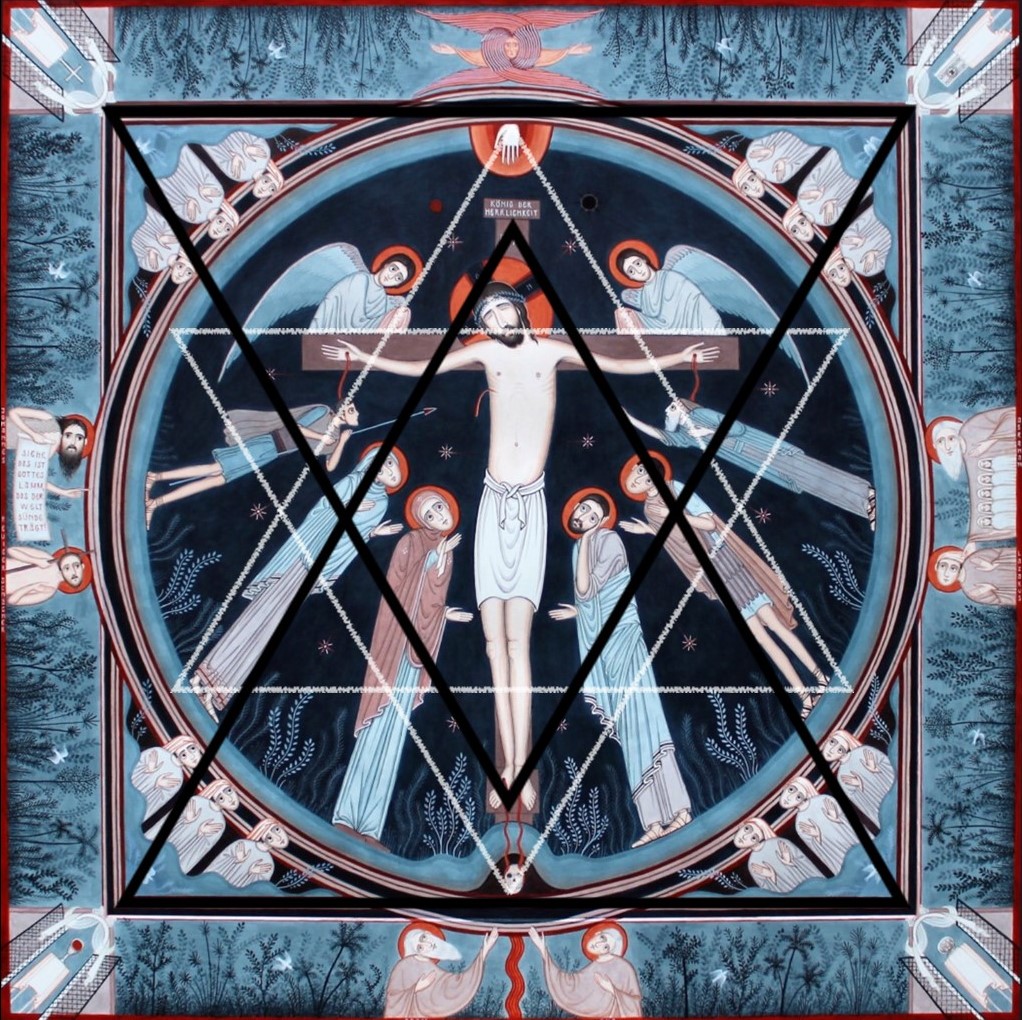Sacred Geometry in Christian Art
Sacred Geometry in Christian Art
by Sophie Hacker
This blog (first presented as a lecture at Sarum College, Salisbury, England) unravels aspects of sacred geometry and how it has inspired art and architecture for millennia. We’ll look at the basis of geometric design, how it was employed in Christian tradition and conclude with examples of contemporary practice.
But what is meant by sacred geometry? Geometry is used in so many creative areas, in architecture, video games, product design, even credit cards have been designed around a geometric ideal. But the geometry we’re concerned with tonight deepens our understanding of a God whose design of our universe is suffused with underlying, exquisite rhythms and proportions.
Humanity didn’t discover geometry, we uncovered it. In this image tribesmen are scribing a circle in the dust using an upright stick and a horizontal stick, which as it’s drawn around the base of the upright scribes a circle on the ground. ‘Geometric’ means ‘earth measure’ and this is where humanity’s connection with geometry starts.
Patterns of repetition can be seen in flowers, the fractal design of a roman cauliflower, the unfurling of a fern in spring, even the way a piece of fruit rots, they all begin with patterns in a circle. The persimmon shows a beautiful eight-pointed star centred around a circle.
So we start with that circle, a universal symbol in so many cultures and faiths of God, Infinity, Unity and Wholeness. To begin the journey into geometry, draw a line and start a new circle by placing the compass point at the intersection X. Draw a second circle to find the lozenge known in Latin as a vesica piscis (“bladder of a fish”), in Italian mandorla (“almond”).
Many early Christian and byzantine images of Christ include the mandorla, a halo that encloses his entire body, though it is significant that in this example Christ’s hand breaches the mandorla to break into the world.
By joining up the points of intersection, equilateral triangles are formed, a symbol of Trinity, with its three identical sides and angles. Equilateral triangles tesselate and also often form the basis in Islamic geometric designs, which can be seen in the next image.
Three as a significant number is found throughout both Old and New Testaments – the Ark of the Covenant contained three sacred objects (a gold jar of manna, Aaron’s staff, the stone tablets of the covenant). There were three temptations in the desert, Christ’s first miracle at Cana happened ‘on the third day’, as did the resurrection.
This image of Islamic geometry shows the tessellation of an equilateral triangle into a more complex form. Note also the rule of ‘six around one’ – a central circle around which six circles are found.
This is a powerful symbol of creation; the six days that God created being the outside circles, the inside one representing the sabbath or rest day. The six around one symbol can be easily illustrated by the use of seven wine glasses, or tennis balls, or any other circular items. Six of equal diameter will ALWAYS fit perfectly around the circumference of the seventh.
So far we have looked at the circle, a universal symbol of God, and the equilateral triangle as a Christian symbol of the Trinity. Moving from three sides to four sides we have the square, symbol of the earth, with its four corners of North, East, South and West, four seasons, four elements, four states of matter. The square is another regular tessellating shape, which is part of Islamic pattern making. This beautiful example is a 16th-century pierced sandstone screen from India. The quality of workmanship is breathtaking. The injunction not to incorporate sentient beings in Islamic art continues to inform its development even today, whilst in the church an incarnate God offers Christians opportunities to explore theology visually and in narrative art.
From the four-sided square, to the five-sided pentagon. Inside the pentagon is the pentagram. With a shape so like a human, arms outstretched, legs astride, this represents humanity. In early medieval symbolism the pentagram also represented the five wounds of Christ. The pentagon also brings us to the all-important Golden Ratio – so significant in sacred art, particularly from the Renaissance onwards. Just how ‘old’ the golden ratio is, is hotly disputed. Some historians say that Stonehenge, the Pyramid at Giza and – rather more likely – the Parthenon all show evidence of using this measurement, others suspect that to be a retrospective imposition. In the diagram shown here each line relates to every other: A is to B what B is to C and C is to D.
Here is a description of how to find the Golden Section, using only a compass and ruler. Start with line AB, draw a line BC at 90 degrees which is half the length of AB. Join AC to create line D. Put your compass point in C measured to B and scribe an arc on the diagonal D. With the compass point in A, open it to D, scribe an arc on AB, at E. E is on the Golden Section of AB, giving you AE and EB as the two useable measurements. So AE is to AB what EB is to AE. The exact ratio is 1:1.618.
The Golden Section, known as Phi, is a proportion found throughout nature, from genetic sequencing, black holes, the arrangement of flower petals and seeds, insects to the human face. It is also expressed widely through a very simple series of whole numbers, known as the Fibonacci series in which the next in the sequence is the sum of the two previous numbers. When composed as a sequence of squares and rectangles, drawn on the golden section, it provides the logarithmic spiral above, one of three main spirals found in nature. The other two are the Archimedian, which like an old vinyl record, has parallel equidistant lines, and the parabolic, which tends to define the pattern in which leaves grown on a stem. We’re going to come back to the Golden Section, but there’s one further polygon to mention, the octagon.
Fonts and baptistries are often octagonal in design. The font on the left is interesting because it echoes an important symbol in Islam called ‘Breath of the Compassionate’, a visual inhalation and exhalation, joining the elements of fire, air, water, earth and the four corners of space. In Islam there are also eight gates of heaven.
The octagon for Christians represents the new day given to humanity at Christ’s resurrection, loosening the bondage of death; eight is the number of the New Beginning. The eighth day is the traditional day for Jewish circumcision and the number of people saved on the Ark, who began a new chapter of the human story. Notice the font on the right also has a square base, rooting it in the earth, whilst the octagonal top speaks of the new beginning and the inner circle completes the sacred geometry with unity and divinity.
Architectural structures have always been dependent on successful geometry for their construction. The rules related to geometry were first written down and used in architectural design in 300 B.C. The glorious cathedrals of Europe are built using sacred geometric principles.
The stonemasons of Winchester Cathedral (above) are mapping out the stone tracery of windows in the north transept, in preparation for repairs. The whole drawing here has been completed using only a compass and rule.
These are the three rose windows and lancets of Chartres Cathedral, a building seeped in geometry, beauty, meaning and symbiology. It deserves an essay in its own right, so I won’t dwell on it now, but it helps to move along the journey to Christian art. It also shows more direct symbolic uses of geometry, as you see the one in twelve ratios, where one represents Christ and twelve are the disciples together with all the shapes included, from circles, squares and triangles.
In Chartres Cathedral the spectacular labyrinth on the nave floor is placed exactly where the rose window would be if the west front was folded down over the floor. The western rose window that depicts the life of Christ and the labyrinth both have a diameter of forty feet, evoking the symbolic use of forty in the bible as a period of testing or trial. For Moses it was forty years in the desert, forty days on mount Sinai. Jesus was tempted for forty days in the wilderness and he appeared during forty days after the resurrection, while on the fortieth day he ascended into heaven.
Once Christianity became the official religion of the Roman Empire, what had been a secretive exploration in the catacombs by gentile artisans began a rapid journey of development. In the western half of the empire one style of work emerged, which was to lead eventually to the Renaissance.
But first we look east. In the Byzantine empire, following the split of the Roman Empire when it became simply too large to govern from Rome, a very particular aesthetic developed. Previously strongly influenced by Hellenistic naturalism, this new style was more abstract.
Realistic proportions, light and color were ignored in favor of geometric simplification of forms, inverse perspective and a profound spiritual intention of offering us a ‘window into heaven’, becoming hieratic, conveying religious meaning.
The well-known example above by Rublev (completed 1425) demonstrates how sacred geometry is used in the eastern tradition. The angels entertained by Abraham in the desert are of course to be interpreted as depictions of the Trinity – with the Spirit on the right, represented by the green robe and the rock above her head. The Son is central, his hand blessing the chalice, robed in red (earthly) and blue (divine). Behind his shoulder emerges the Tree of Knowledge and the Tree of the Cross. On the left is the Father, robed in the gold of glory. He sits before the Holy City of Jerusalem. Each figure holds a red staff of authority to confirm that none takes precedence over the other, though the head of the Christ is inclined in obedience to the Father.
Here some of the geometry underlying the icon is revealed. The figures sit within an octagon, the Son and the chalice hold the central axis but reconnect to the other persons by a horizontal diameter. Three equilateral triangles are shown but there are many in the composition. Rublev also uses inverse perspective (on the dais platforms) to create a ‘space’ for the worshipper to be included in the dynamic.
This painting is separated by only a handful of decades from Rublev’s one, but they are worlds apart. In this Resurrection of Christ (completed 1465) there is attention to human proportion, musculature, perspective, foreshortening, tonal values, nature. What we see is much more a window on the recognizable world, despite the miraculous nature of the event.
Pierro Della Francesca was a consummate mathematician as well as a noted painter of the early Renaissance. There is a famous story about this fresco in the church of Sansepolcro, Tuscany. Close to the end of World War II Sansepulcro was under bombardment by the Allied Forces. A British officer, Anthony Clarke, had learned about the significance of Pierro Della Francesca during his school days at Winchester College. He persuaded his troops to cease fire, saving the church and the fresco.
Geometry offers a deeper reading of the imagery. Notice the circle – the whole of the figure of Christ is contained within it. Its edges touch the trees representing, on the left, the unredeemed fallen world before the resurrection: the trees and landscape are barren and dead. On the right, after the resurrection, the trees are in full leaf, the ground is fertile. The pentagram provides many key locations: the horizon, the top of the tomb, the flow of line through the soldiers and positioning of Christ’s body. One of many equilateral triangles connects the base of the action with the brow of Christ’s nose, lifting our eye to his steady gaze.
This extraordinary painting by Da Vinci (1472) is meant to be viewed from the lower right corner. Then the strange foreshortening of the virgin’s arm and the architectural strangeness all make sense. The technique is called anamorphosis and there is a theory that Leonardo may have developed it.
There are many golden sections to be found in the painting. The central axis is clear again, this time separating the space between the virgin and the angel, marking the different realms the two inhabit. Notice how the following golden sections fall through compositional elements – the forehead of the Angel, the stylistically different tree above the wings. Additional golden sections are located on the edges of the masonry and horizontally through several compositional elements.
Julia Stankova's The Healing of the Demon-Possessed Man is a small painting, only 40x30 cm. This is a tender depiction of Christ’s reaction to the man healed of his demons, who are sent into the pigs. After years of living homeless and naked among the tombs, here he now is, seated at Christ’s feet, clothed and sane. Christ, in receiving his thanks, commands him to return to his village and tell them about the mercy of God.
Here is added one equilateral triangle and two golden sections, showing how the golden sections divide the picture plane into specific parts. The right side holds the body of Christ, the bottom left section holds the body of the healed man. An equilateral triangle contains the most significant dialogue of hands and faces. The incline of Christ’s head mirrors the angle of the triangle, as does the splash of water as the possessed swine tumble in.
Nikola Saric was born in 1985 in Serbia. He trained in the Academy of Serbian Orthodox Church for Arts and Conservation. His work conveys the image of a transfigured world with interpretations that reflect a style that breathes and evolves with contemporary practice. Icons they are certainly not, because he makes a new language and invents compositions rather at odds with the tradition, yet they have a similar serenity.
This slide shows some of the complex geometry to be found within the design. There are many triangles, providing the structure against which the angels are depicted. Equilateral triangles spring from the top and the bottom of the outlying square, with their points located at key places in the design. A six-pointed star also hits key points. The main triangle in the design is implicit even without the lines shown.
“Art is the daughter of the Divine,” Rudolf Steiner said. There is much more to be said about this rich and complex subject, but Steiner’s quote is one way to conclude this lighting tour though a fraction of what there is to be discovered.
*******
Sophie Hacker specialises in Church Art, including stained glass windows, vestments and re-ordering liturgical space. She is a trustee of A+CE, the UK's leading organisation in the field of visual art and religion, and a Visiting Scholar at Sarum College in Salisbury Cathedral Close. Since 2006 she has been Arts and Exhibitions Consultant for Winchester Cathedral, with particular responsibility for curating three exhibitions each year. http://www.sophiehacker.com



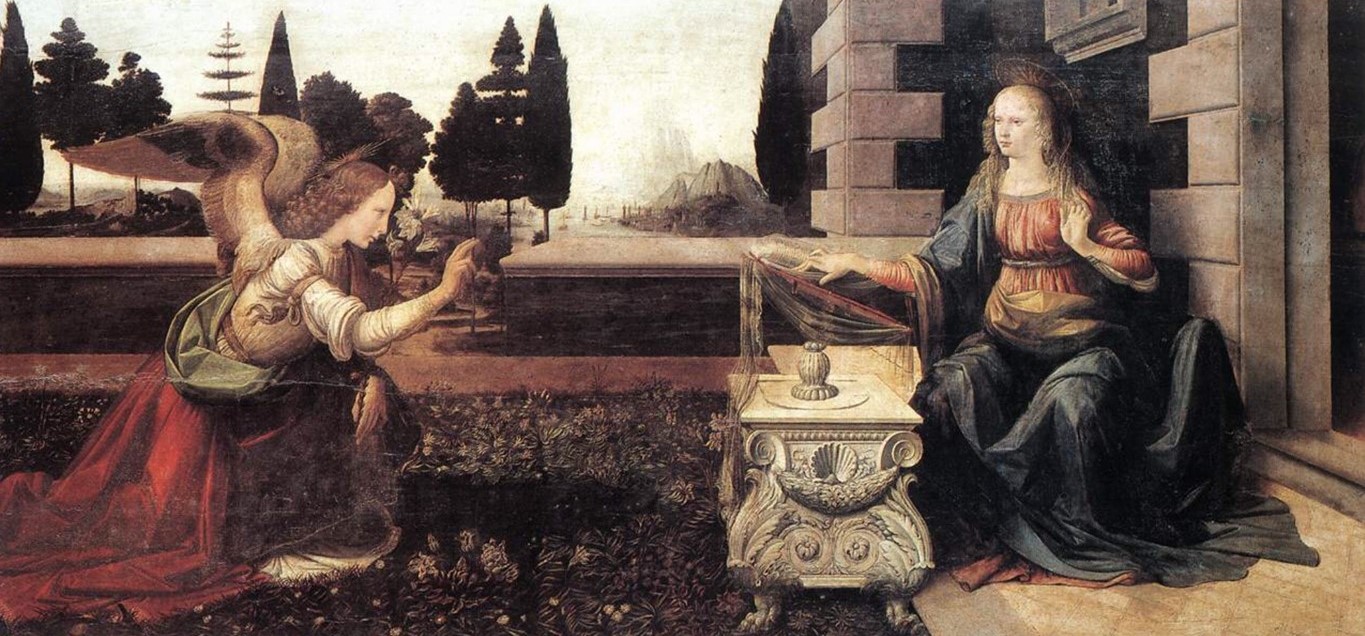
.JPG)
.JPG)
.JPG)
.JPG)
.JPG)

